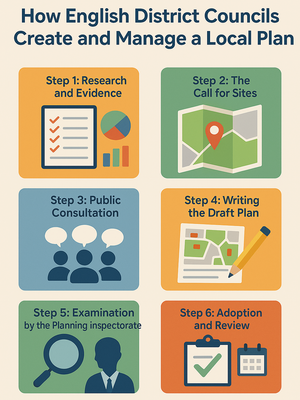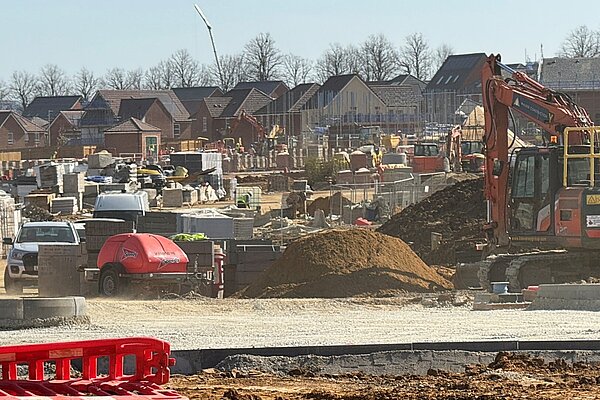How English District Councils Create and Manage a Local Plan
How do District Councils shape where homes, jobs & green spaces go?
Every council must create a Local Plan—but what happens if they don’t?
Find out how plans are made, why they matter & what’s at stake if targets are missed.
1. English planning law requires every Local Planning Authority (LPA) to create a Local Plan—a framework that sets out how an area will grow over the next 10 to 15 years. This includes planning for housing, employment sites, countryside protection, and other development policies. Councils must ensure the right number of homes are built to meet population growth and migration into the area, and that they are in the right places—supported by appropriate infrastructure such as roads, footways, public transport, schools, shops, utilities, employment opportunities, and green spaces.
2. To support this, central government sets housing targets. These targets are based on factors such as projected population growth, past development trends, local wages, and housing affordability. The LPA, usually the District or Borough Council (or a Unitary Authority in some areas), is responsible for meeting these targets.
Why a Local Plan Matters
3. If an LPA fails to meet its housing targets or lacks an up-to-date Local Plan, several consequences follow:
3.1 Developers gain more power: It becomes harder for the council to refuse planning applications—even in locations that may be unpopular locally.
3.2 Green spaces come under threat: Without a plan in place, undeveloped countryside or valued open land is more likely to be built on.
3.3 Government intervention: The national government can take over parts of the planning process if councils don’t take timely action.
4. Even if a Local Plan exists, the same penalties apply if the annual housing delivery rate falls below the required level. Government now also requires evidence of a five-year housing land supply, including a 5% buffer.
What Is a Local Plan?
5. A Local Plan is a strategic document, often described as a rulebook, that guides how an area will grow and develop. It identifies where new homes, roads, shops, schools, employment land, and green spaces can go, and includes planning policies to ensure this growth happens in a way that protects the landscape, the environment, and historic places.
6. The Local Plan is written by the Local Planning Authority—which in most cases means the District or Borough Council—with support from consultants, community input, and a wide range of technical evidence.
Step-by-Step: How a Local Plan Is Made

Step 1: Research and Evidence
7. Councils begin by collecting evidence to understand local needs and constraints. This includes:
7.1 Population trends and household growth
7.2 Expected inward migration (especially for LPAs near large cities like London)
7.3 Existing housing types and affordability
7.4 Infrastructure capacity (e.g. schools, health services, transport)
7.5 Environmental constraints (e.g. flood risk, air quality, water supply)
7.6 Protected areas such as ancient woodland, nature reserves, and farmland
8. This evidence underpins all future planning decisions.
Step 2: The Call for Sites
9. Next, the LPA invites landowners, developers, parish councils, and local residents to suggest land for potential development. This may include fields near villages, infill plots, or brownfield (previously developed) land.
10. Each site is assessed to determine whether it is:
10.1 Suitable (not too steep, contaminated, or at flood risk)
10.2 Available (the landowner is willing to release it)
10.3 Achievable (it can be developed within the plan period—typically 10–15 years)
11. Only sites supported by robust evidence are considered for inclusion in the draft plan.
Step 3: Public Consultation
12. The council then seeks views from the public and key stakeholders such as:
12.1 Parish councils
12.2 Utility companies
12.3 Health and Education Authorities
12.4 Local businesses and residents
13. People can raise concerns about issues like traffic, school capacity, wildlife, or infrastructure. The LPA must consider these views and may revise the plan accordingly.
Step 4: Writing the Draft Local Plan
14. The council produces a Draft Local Plan, which includes:
14.1 Maps showing where development can go
14.2 Housing and Traveller pitch targets
14.3 Design standards and sustainability policies
14.4 Protection for nature, heritage, and key landscapes
15. This draft is then published for further public consultation.
Step 5: Examination by the Planning Inspectorate
16. The final version of the Local Plan is submitted to a government-appointed Planning Inspector, who checks it for legal compliance and evidence. A series of formal public hearings are held, where experts, developers, and residents can speak.
Step 6: Adoption and Ongoing Review
17. If the Planning Inspector finds the plan "sound" (usually subject to some changes), the LPA can adopt it. Once adopted, it becomes the statutory planning framework for the area.
18. Plans must be reviewed at least every 5 years to remain relevant. Changing a plan before that point requires starting the process again—an expensive and time-consuming undertaking.
What Happens If a Council Has No Local Plan?
19. A Local Plan is not optional. Without one—or if the plan is out of date or housing delivery is too low—the consequences are serious:
19.1 Developers can build in places the council wanted to protect
19.2 Bad applications are harder to refuse
19.3 The government may take over parts of the process
19.4 Local services may become overwhelmed
19.5 Councils risk losing planning appeals or facing legal challenges
20. These risks still apply even if housing under delivery is due to external factors like a recession, contractor shortages, or delays from developers.

In Summary:
21. A Local Plan is essential. It allows Local Planning Authorities—usually District or Borough Councils—to plan for housing, jobs, and infrastructure, while protecting the things local communities care most about: green spaces, heritage, and character.
22. The process is evidence-based, participative, and legally mandated. Getting it right gives councils—and communities—control over how they grow. Failing to do so risks losing that control altogether.